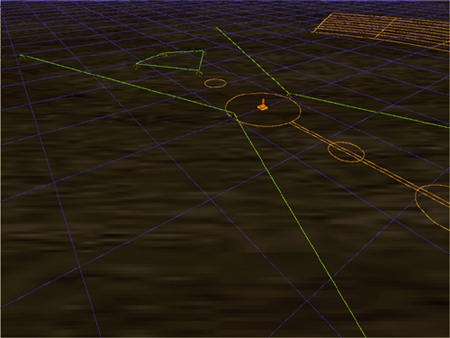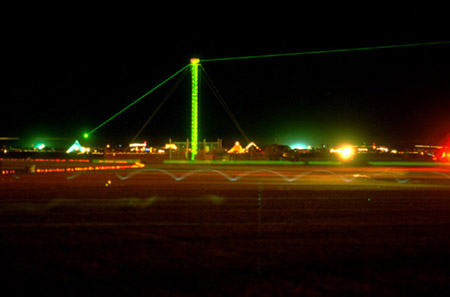The Beaming Man
by Russell Wilcox



The Beaming Man
by Russell Wilcox

|
The Beaming Man (as if viewed from 600 feet altitude), 2000 computer graphics (© Russell Wilcox.) |

|
The Beaming Man (a waist tower looking toward the right leg), 2000 laser installation, 4000' x 2000' (© Russell Wilcox. Photo: Al Wildey.) |
|
Beaming Man, a laser installation at Burning Man 2000, was the largest human figure ever created. England's Cerne Abbas Giant is 180 feet tall; the Chilean "Giant of Atacama" is 393 feet; while the Beaming Man was 4000 feet long and 2000 feet wide, made of laser beams suspended 30 feet over the desert floor. To create this, we used three lasers, ten 30-foot antenna towers, and an array of laser optics and mechanical hardware. The human figure with his arms raised above his head was a linearized form of the Burning Man logo. This formed a body within which other artworks were organs. The concept was originated by Larry Harvey and city architect Rod Garrett, and I turned it into reality while maintaining aesthetic quality and content. I had built a 25-foot laser installation at Burning Man 1999 called The Tetrahedron, where I developed the technical and artistic approach that informed Beaming Man. Laser beams are an ideal medium for large artworks, since they create lines of light that can be made arbitrarily long, limited only by the diameter of the beam and the quality of the optical components. Beams have an ethereal quality that is at once perfectly straight and stable yet intangible and transparent. While laser shows at the event scanned their beams across the sky, the Beaming Man lasers defined stationary lines, quietly adding a touch of spacey surreality to the area around them. Three solid-state green lasers (two 5-Watt and one 3-Watt) and optics assemblies on the ground emitted beams that were sent up to the top of three "source towers." Mirrors at the tops of these towers directed some of the beams to "target towers" 2000 feet away where they were stopped by white, four-foot square panels. Other beams hit secondary mirrors on distant towers before being directed to a target. Aligning the beams to these widely separated mirrors and targets required very stable structures, precision adjustments of the mirrors, and special procedures that had to be developed during installation. We hoped some sensitive people would fully explore the figure on foot or by vehicle, since this was the only way its true shape could be appreciated from the ground. This appreciation exercise emphasized the importance of memory in imparting a sense of scale. Due to a laser beam's ethereality, it's impossible to judge one's distance from it, making estimation of Beaming Man's size delightfully difficult. Some participants enjoyed the transformation of space wrought by this phenomenon, and would continuously look upward while riding bicycles under the beams. Near the Burning Man there were two laser towers which glowed green from the ascending beams, adding complementary forms and colors to the area. Beaming Man showed that an otherwise delicate and precise laser installation could withstand the rigors of the Black Rock City environment, and that the medium of stationary laser beams is an impressive and expressive one, worthy of continued exploration. Russell Wilcox E-mail: rwilcox@jps.net |
| Burning Man |
| gallery entrance |
| past exhibitions |
| Leonardo On-Line |